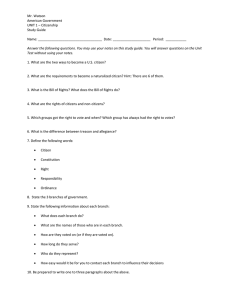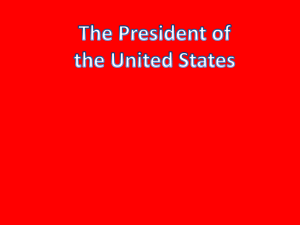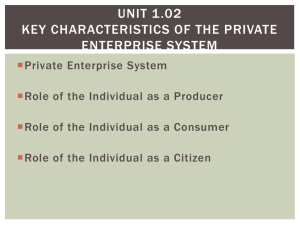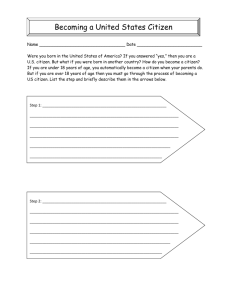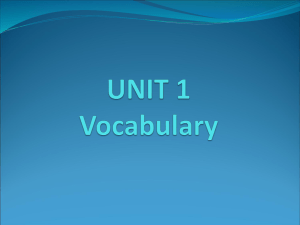Citizen Science: An Overview
advertisement
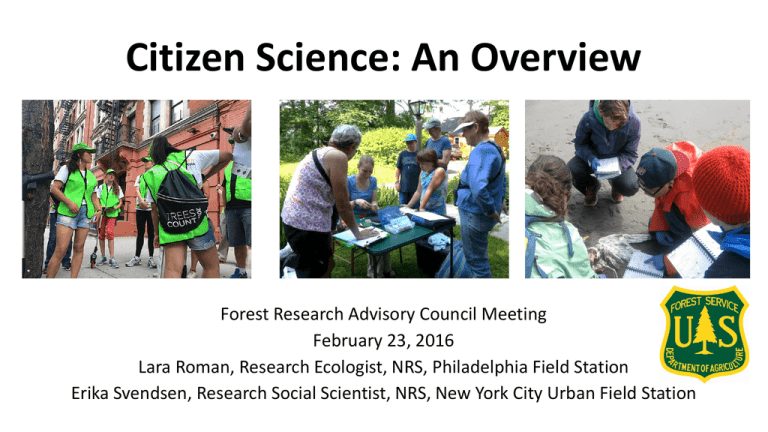
Citizen Science: An Overview Forest Research Advisory Council Meeting February 23, 2016 Lara Roman, Research Ecologist, NRS, Philadelphia Field Station Erika Svendsen, Research Social Scientist, NRS, New York City Urban Field Station This presentation is based on… Duncan McKinley Research & Development, Policy Analysis What is citizen science? G. Renee Guzlas, artist Definitions The collection and analysis of data relating to the natural world by members of the general public, typically as part of a collaborative project with professional scientists. (Oxford Dictionary 2015) Partnerships between the public and professional scientists to address questions and issues of common concern. Usually when people refer to citizen science they mean projects for which members of the public collect, categorize, transcribe, or analyze scientific data. (Cornell Lab of Ornithology) Definitions The collection and analysis of data relating to the natural world by members of the general public, typically as part of a collaborative project with professional scientists. (Oxford Dictionary 2015) Partnerships between the public and professional scientists to address questions and issues of common concern. Usually when people refer to citizen science they mean projects for which members of the public collect, categorize, transcribe, or analyze scientific data. (Cornell Lab of Ornithology) Participation by the public in a scientific project. Projects can involve public participation in any or all stages of the scientific process. Projects can involve professional scientists or be entirely designed and implemented by volunteers. (McKinley et al. 2015) The public participates voluntarily in the scientific process, addressing real-world problems in ways that may include formulating research questions, conducting scientific experiments, collecting and analyzing data, interpreting results, making new discoveries, developing technologies and applications, and solving complex problems. (White House Office of Science and Technology Policy) Definitions The collection and analysis of data relating to the natural world by members of the general public, typically as part of a collaborative project with professional scientists. (Oxford Dictionary 2015) Partnerships between the public and professional scientists to address questions and issues of common concern. Usually when people refer to citizen science they mean projects for which members of the public collect, categorize, transcribe, or analyze scientific data. (Cornell Lab of Ornithology) Participation by the public in a scientific project. Projects can involve public participation in any or all stages of the scientific process. Projects can involve professional scientists or be entirely designed and implemented by volunteers. (McKinley et al. 2015) The public participates voluntarily in the scientific process, addressing real-world problems in ways that may include formulating research questions, conducting scientific experiments, collecting and analyzing data, interpreting results, making new discoveries, developing technologies and applications, and solving complex problems. (White House Office of Science and Technology Policy) Crowdsourcing: organizations submit an open call for voluntary assistance from a large group of individuals for online, distributed problem solving. (White House Office of Science and Technology Policy) Growth of citizen science scholarship McKinley et al. 2015 Why use citizen science? • Builds public trust • Enhances scientific literacy • Facilitates scientific research and resource management • Fosters open and transparent government practices • Catalyzes innovative use of technologies • Creates and strengthens partnerships Federal support for citizen science & crowdsourcing 1) Federal Citizen Science and Crowdsourcing Toolkit released 2) Office of Science and Technology Policy memo from Director John Holdren on crowdsourcing and citizen science 3) National Science Foundation announced core priority in citizen science and crowdsourcing 4) Citizen science & crowdsourcing legislation introduced by Senator Chris Coons (DE) Diversity of citizen science projects Citizen science in policy & decision-making Identification Scientific Information Public Input Effects of Public Engagement Other actions Formulation Decisionmaking Adoption Natural Resource Management/Policy Decision Implementation Management/Policy Outcome Evaluation Citizen Science Direct effects Indirect effects McKinley et al. (2015) Example 1: eBird • 272 million observations from over 200,000 individuals • Extensive global coverage Example 2: National Phenology Network Courtesy of NPN Example 3: Collaborative Forest Landscape Restoration Program (CFLRP) • Encourages collaborative, science-based ecosystem restoration of forest landscapes • Promotes ecological, economic, and social sustainability (strong focus on reducing uncharacteristic wildfires) • Monitors management outcomes for 15 yrs via multiparty monitoring / citizen science Example 4: Neighborhood Nestwatch • Science • • • Monitor backyard bird populations Identify management regimes Improve wildlife habitat • Engagement • • • Partner with households Increase environmental literacy Reconnect people with nature PI: Peter Marra, Smithsonian Migratory Bird Center coPI: Susannah Lerman, US Forest Service Example 5: TreesCount! 2015 • Decadal street tree census in NYC • FS and USDA contributions: • Grants for OpenTreeMap • Assessing volunteer errors • Research on citizen science for civic engagement Who participates? • Does citizen science really… • Engage diverse constituencies? • Promote scientific literacy? • Promote environmental stewardship & civic engagement? 18 Participatory action research A participatory, democratic process … in the pursuit of practical solutions to issues of pressing concern to people, and more generally the flourishing of individual persons and communities (Reason & Bradbury 2001, Green et al. 2003) Data quality? • Sampling bias in crowdsourcing • Uneven spatial & temporal distribution • Observation error • Species misclassification • Urban trees: 92% correct genus (Roman et al. in preparation) • Bees: volunteers missed half the species (Kremen et al. 2011) • Birds: common species more accurate (Farmer et al. 2012) • Measurement error • Urban trees: DBH issues for multi-stem trees (Roman et al. in preparation) • Woody biomass: similar estimates from community members & professionals (Danielsen et al. 2011) Mechanisms for ensuring data quality • Repeated samples • Uniform or calibrated equipment • Understanding volunteer skills • Training & testing volunteers • Filter unusual reports • Expert review / validation • Data triangulation • Data quality documentation Wiggins et al. (2011) Conclusions • Benefits to research, policy and communities • Opportunities to strengthen partnerships • Support from across federal government • Citizen science is science • Mechanisms to address data quality • Citizen science does not devalue “conventional” research • Part of a broader array of public participation in scientific research Thank you! Federal Crowdsourcing and Citizen Science Toolkit: https://crowdsourcing-toolkit.sites.usa.gov/ Internal Citizen Science and Crowdsourcing Sharepoint Site: https://ems-team.usda.gov/sites/fs-nrm-imac/SitePages/Citizen%20Science!.aspx Forest Service Citizen Science and Crowdsourcing external site: http://www.fs.fed.us/naturewatch/citizen-science.php

